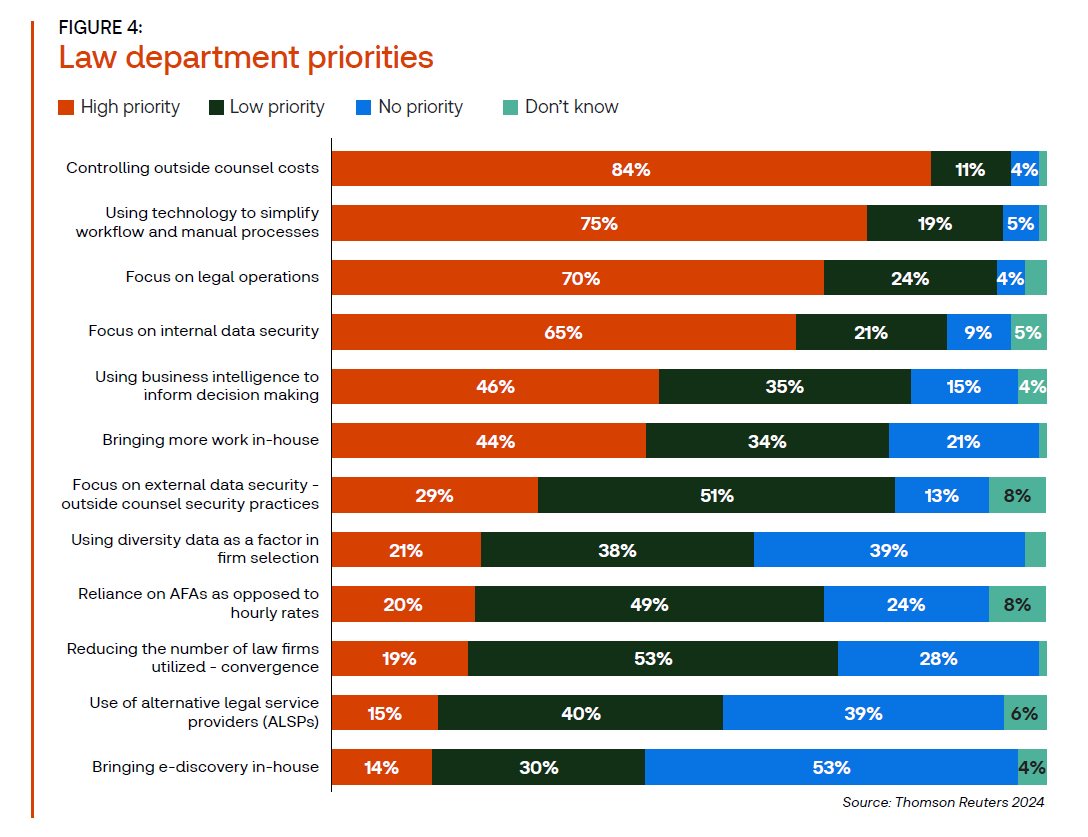In-house team challenges of increasing matter volumes and budget pressures have legal departments looking for greater efficiency and cost savings
Corporate law departments are facing increasing matter volumes and a desire to improve workflows through technology, but also are seeing flat to declining attorney staffing and legal tech budgets, according to the Thomson Reuters Institute’s 2024 Legal Department Operations Index report. The annual report, produced in collaboration with the Legal Value Network, engages in an in-depth examination of the current state of affairs for in-house legal department operations. (The report gathered the findings from online survey of 80 legal department operations professionals in the United States.)
Among the four key focal areas of special interest to in-house legal departments — effective operations, cost efficiency, protecting the broader enterprise, and enabling strategic growth — effectiveness and efficiency most directly implicate the operations functions of in-house legal departments.
Unsurprisingly, the need to control outside counsel costs tops the list of high-priority challenges for legal operations teams, the report shows. While this challenge perpetually tops the list of department priorities, it is particularly noteworthy this year for the 6-percentage-point jump in the number of respondents characterizing cost controls as a high priority compared to last year.

Among other high priority focuses for law departments are such challenges as using technology to simplify workflows and manual processes, focusing on legal operations, and ensuring internal data security.
Nearly every survey respondent said their corporate law department was seeing increasing matter volumes (79%) or flat volumes (14%). At the same time, more than half (58%) report flat to decreasing total department budgets, and two-thirds (67%) report flat or decreasing attorney headcount.
While this recipe for do more with less is not a new problem for corporate legal departments, however, as the problem has continued year after year, law departments have seen little if any relief from the constant pressure to keep up with an increasingly complex business world. As a result of this pressure, many law departments are looking to technology to alleviate some of the burden, chiefly by increasing team capacity through productivity and efficiency gains without the need to add headcount.
Standing as a potential hurdle to this progress is the reality of law department technology budgets. While 36% of respondents reported that they were seeing increasing legal tech budgets, 57% said that their tech budgets were staying flat or even shrinking. Those departments with budget challenges are not necessarily without options, however. Many departments are exploring tech upgrades as replacement costs, in which upgraded technology takes the place of other items in the department budget, enabling the budget to remain flat, or in some cases even decrease, rather than showing new tech investment as a net-spend increase.
Also noteworthy in the report is the finding that a relatively small percentage of respondents report that their departments are seeing an increase in the percentage of work handled in-house. Only 36% of respondents reported an increasing proportion of in-house matters, while 50% said that their share of in-house legal work had remained flat, and 5% said their proportion had actually shifted toward outside counsel.
Examining how progress is measured
While nearly every corporate law department is tracking key metrics, according to respondents, when they are asked which metrics their departments track, it became readily apparent that in-house legal teams are tracking metrics related to cost efficiency almost exclusively. Indeed, metrics that track other key areas of focus are much less common. In particular, qualitative metrics such as the quality of matter outcomes, law firm diversity, or outside counsel evaluation results are tracked by just one-quarter or less of law departments, according to the survey. Even potentially insightful cost metrics like savings from technology or benefits from alternative fee arrangements are only tracked by about 1-in-10 law departments.
Among the metrics tracked, forecasted spend compared to actual spend ranked as the most important metric, with total spend by law firm following as the second-most often cited by respondents as most important metric.
However, nearly every highly ranked metric dealt with total spend, often just broken down in various ways. The exception was quality of legal outcomes, which was ranked as quite important by those respondents who reported that they were using that metrics — however, only about one-quarter of respondents said their law departments use it.
As the report demonstrates, prioritizing cost control, technology adoption, and comprehensive metrics tracking will help in-house legal departments better navigate budgetary pressures, enhance their overall performance, and provide greater value to their organization.
You can download a full copy of the Thomson Reuters Institute’s 2024 Legal Department Operations Index here.







